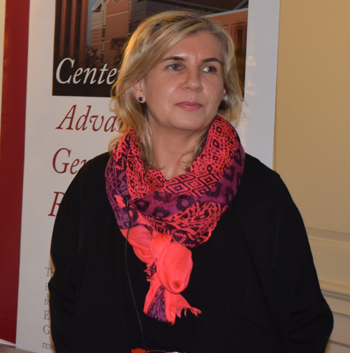
Simone Gigliotti
Simone Gigliotti teaches in the history program at Victoria University in Wellington, New Zealand, and is a member of the Holocaust Geographies Collective, a group of researchers who study the Holocaust in terms of geography and movement of survivors and victims. She is the first official visiting scholar to the Center, which includes a week-long residency for Gigliotti to conduct research in the Visual History Archive and give a public lecture at USC.
Her public lecture on Tues., Nov. 11, was titled “A Mobile Holocaust: Testimony and the Spatial Turn.” Gigliotti reported on an analytical effort to identify criteria for “spatial experience” in USC Shoah Foundation testimonies.
During her residency at USC Shoah Foundation this week, Gigliotti is conducting research for her online book-length project Enough of this Europe: Routes to Home and Humanity after the Holocaust, which examines the cinematic representation of refugee quests for national belonging, homelands and human rights in the post-genocide and post-war displaced-persons “DP” era in Europe from 1945 to 1952. Specifically, she is looking for testimonies of Holocaust survivors who worked for DP camp newspapers, toured government officials around DP camps, participated in cultural activities in DP camps and more in order to gain an understanding of the refugee experience after the war. She is also interested in transmigration of Jews throughout Southeast Asia.
Though she has worked with testimonies before, including co-creating an exhibit about Holocaust survivors who immigrated to New Zealand, Gigliotti’s visiting scholarship is a rare opportunity for her to engage deeply with the Visual History Archive. She said the experience is “incredible and immersive,” and even overwhelming at times. But it’s an ideal resource for researching the refugee experience, she said.
“You can see different potential research directions that you wouldn’t otherwise find in other disparate archives,” Gigliotti said. “What interests me is doing [research] on a map and seeing the cluster of places and testimonies or voices in a particular region. You can go to India, Sri Lanka, or Hong Kong and wonder, What were these people’s journeys and why are they here? And what happens next?”
Gigliotti said the themes of displacement and unwelcome attitudes toward refugees before and after the Holocaust are still very relevant to today.
“This postwar period really exemplifies the problems Jews had before the war in 1933 that didn’t go away. Those issues of finding a home continued,” Gigliotti said. “This is an issue today when you look at major displacement of Syrians and various genocides and the Middle East, it’s just ongoing.”
Gigliotti said she hopes that Victoria University is one day a Visual History Archive Access site, so that her students can utilize the archive in their research.
“I think students are really fortunate to be here [at USC],” she said. “To have the archive onsite, and with a diverse student body, it has an immediate potential impact in terms of accessibility and integration into academic study and research projects.”